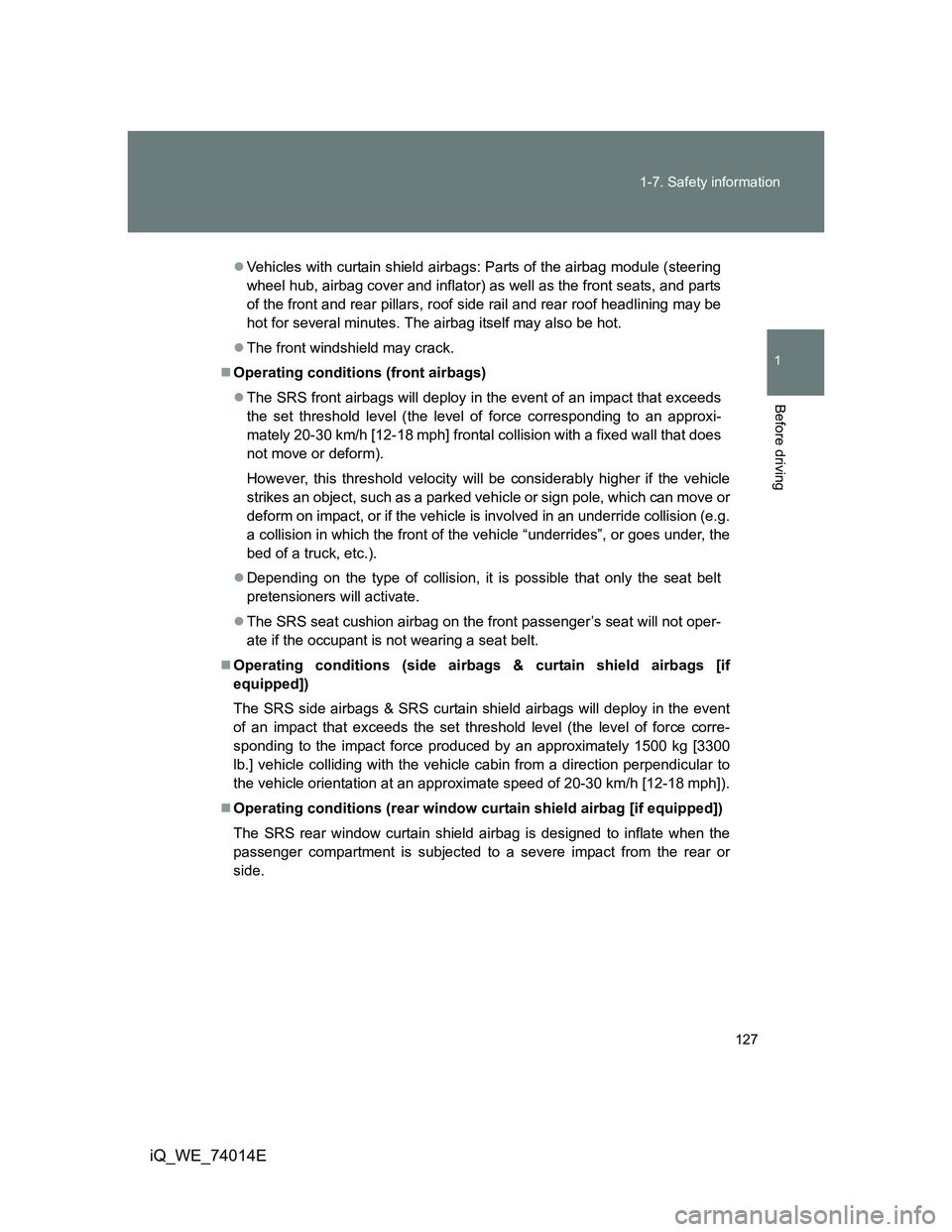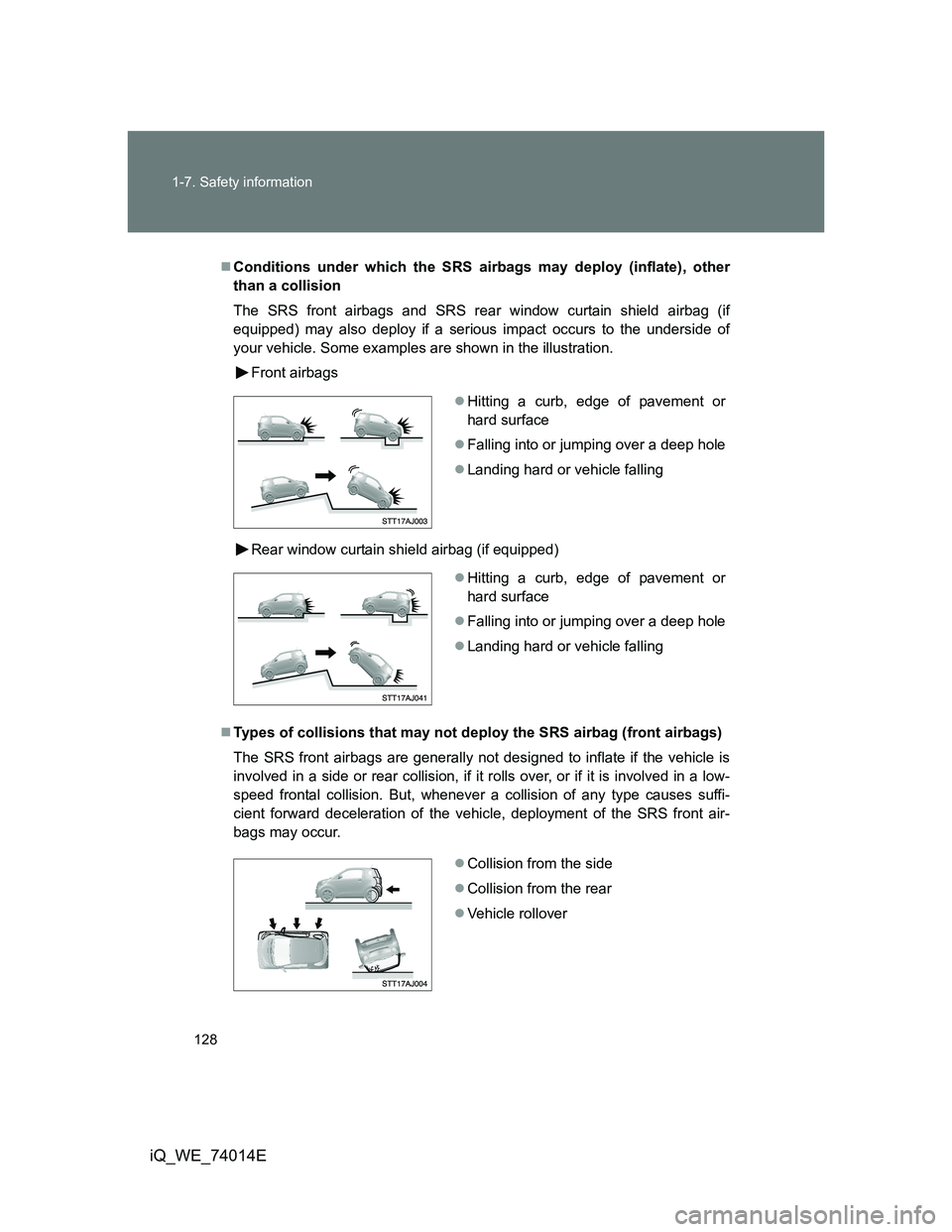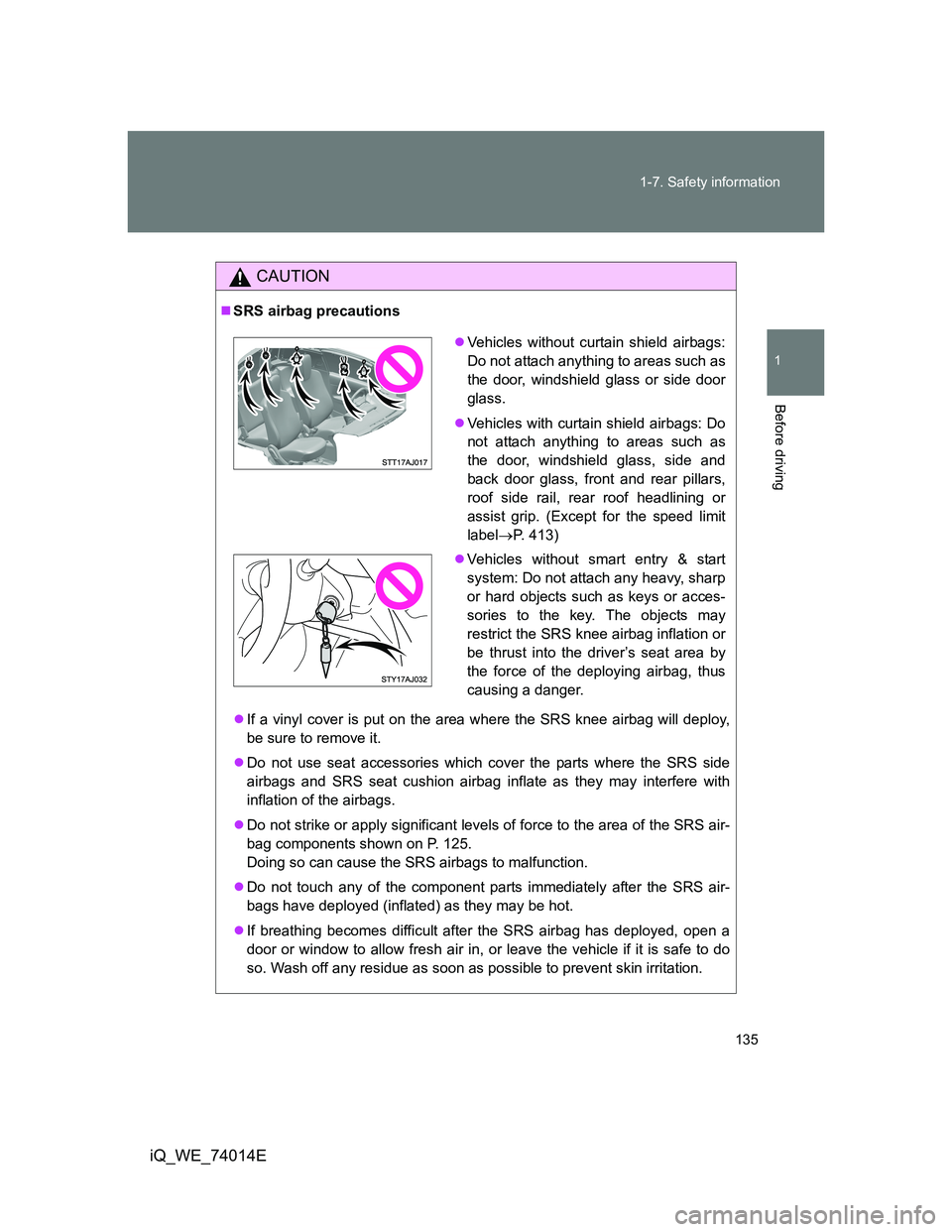Page 126 of 476

126 1-7. Safety information
iQ_WE_74014EThe main SRS airbag system components are shown above. The
SRS airbag system is controlled by the airbag sensor assembly. As
the airbags deploy, a chemical reaction in the inflators quickly fills the
airbags with non-toxic gas to help restrain the motion of the occu-
pants.
Rear airbag sensors
(if equipped)
Curtain shield airbag sen-
sors (if equipped)
Curtain shield airbags
(if equipped)
Side airbags
Front passenger airbag
Passenger airbag indicator
light
Seat belt pretensioners and
force limiters
Vehicles without curtain
shield airbags: Side air-
bag sensors
Vehicles with curtain
shield airbags: Side and
curtain shield airbag
sensorsSeat cushion airbag
Front airbag sensors
Airbag sensor assembly
Front passenger’s seat belt
buckle switch
Rear window curtain shield
airbag (if equipped)
SRS warning light
Driver airbag
Knee airbag
Airbag manual on-off switch
If the SRS airbags deploy (inflate)
Bruising and slight abrasions may result from contact with a deploying
(inflating) SRS airbag.
A loud noise and white powder will be emitted.
Vehicles without curtain shield airbags: Parts of the airbag module (steer-
ing wheel hub, airbag cover and inflator) as well as the front seats may
be hot for several minutes. The airbag itself may also be hot.
Page 127 of 476

127 1-7. Safety information
1
Before driving
iQ_WE_74014E
Vehicles with curtain shield airbags: Parts of the airbag module (steering
wheel hub, airbag cover and inflator) as well as the front seats, and parts
of the front and rear pillars, roof side rail and rear roof headlining may be
hot for several minutes. The airbag itself may also be hot.
The front windshield may crack.
Operating conditions (front airbags)
The SRS front airbags will deploy in the event of an impact that exceeds
the set threshold level (the level of force corresponding to an approxi-
mately 20-30 km/h [12-18 mph] frontal collision with a fixed wall that does
not move or deform).
However, this threshold velocity will be considerably higher if the vehicle
strikes an object, such as a parked vehicle or sign pole, which can move or
deform on impact, or if the vehicle is involved in an underride collision (e.g.
a collision in which the front of the vehicle “underrides”, or goes under, the
bed of a truck, etc.).
Depending on the type of collision, it is possible that only the seat belt
pretensioners will activate.
The SRS seat cushion airbag on the front passenger’s seat will not oper-
ate if the occupant is not wearing a seat belt.
Operating conditions (side airbags & curtain shield airbags [if
equipped])
The SRS side airbags & SRS curtain shield airbags will deploy in the event
of an impact that exceeds the set threshold level (the level of force corre-
sponding to the impact force produced by an approximately 1500 kg [3300
lb.] vehicle colliding with the vehicle cabin from a direction perpendicular to
the vehicle orientation at an approximate speed of 20-30 km/h [12-18 mph]).
Operating conditions (rear window curtain shield airbag [if equipped])
The SRS rear window curtain shield airbag is designed to inflate when the
passenger compartment is subjected to a severe impact from the rear or
side.
Page 128 of 476

128 1-7. Safety information
iQ_WE_74014E
Conditions under which the SRS airbags may deploy (inflate), other
than a collision
The SRS front airbags and SRS rear window curtain shield airbag (if
equipped) may also deploy if a serious impact occurs to the underside of
your vehicle. Some examples are shown in the illustration.
Front airbags
Rear window curtain shield airbag (if equipped)
Types of collisions that may not deploy the SRS airbag (front airbags)
The SRS front airbags are generally not designed to inflate if the vehicle is
involved in a side or rear collision, if it rolls over, or if it is involved in a low-
speed frontal collision. But, whenever a collision of any type causes suffi-
cient forward deceleration of the vehicle, deployment of the SRS front air-
bags may occur.
Hitting a curb, edge of pavement or
hard surface
Falling into or jumping over a deep hole
Landing hard or vehicle falling
Hitting a curb, edge of pavement or
hard surface
Falling into or jumping over a deep hole
Landing hard or vehicle falling
Collision from the side
Collision from the rear
Vehicle rollover
Page 130 of 476
![TOYOTA IQ 2012 Owners Manual 130 1-7. Safety information
iQ_WE_74014E
Types of collisions that may not deploy the SRS airbag
(rear window curtain shield airbag [if equipped])
The SRS rear window curtain shield airbag is gener TOYOTA IQ 2012 Owners Manual 130 1-7. Safety information
iQ_WE_74014E
Types of collisions that may not deploy the SRS airbag
(rear window curtain shield airbag [if equipped])
The SRS rear window curtain shield airbag is gener](/manual-img/14/60097/w960_60097-129.png)
130 1-7. Safety information
iQ_WE_74014E
Types of collisions that may not deploy the SRS airbag
(rear window curtain shield airbag [if equipped])
The SRS rear window curtain shield airbag is generally not designed to
inflate if the vehicle is involved in a front collision, if it rolls over, or if it is
involved in a low-speed rear or low-speed side collision.
When to contact any authorized Toyota dealer or repairer, or another
duly qualified and equipped professional
In the following cases, contact any authorized Toyota dealer or repairer, or
another duly qualified and equipped professional, as soon as possible.
Any of the SRS airbags have been inflated.
Collision from the front
Vehicle rollover
The front of the vehicle is damaged or
deformed, or was involved in an acci-
dent that was not severe enough to
cause the SRS airbags to inflate.
A portion of a door is damaged or
deformed, or the vehicle was involved
in an accident that was not severe
enough to cause the SRS side airbags
and curtain shield airbags (if equipped)
to inflate.
Page 131 of 476

131 1-7. Safety information
1
Before driving
iQ_WE_74014E
Vehicles with rear window curtain shield
airbag: The rear of the vehicle is dam-
aged or deformed, or the vehicle was
involved in an accident that was not
severe enough to cause the SRS rear
window curtain shield airbag to inflate.
The pad section of the steering wheel
or dashboard near the front passenger
airbag cover or lower portion of the
instrument panel is scratched, cracked,
or otherwise damaged.
Front passenger seat: The seat cushion
surface is scratched, cracked, or other-
wise damaged.
The surface of the seats with the side
airbag is scratched, cracked or other-
wise damaged.
Vehicles with curtain shield airbags:
The portion of the front pillars, rear pil-
lars or roof side rail garnishes (padding)
containing the curtain shield airbags is
scratched, cracked or otherwise dam-
aged.
Vehicles with rear window curtain shield
airbag: The portion of the rear roof
headlining or rear pillars containing the
rear window curtain shield airbag is
scratched, cracked or otherwise dam-
aged.
Page 134 of 476
134 1-7. Safety information
iQ_WE_74014E
CAUTION
SRS airbag precautions
Do not allow anyone to kneel on the
passenger seat toward the door or put
their head or hands outside the vehicle.
Vehicles with rear window curtain shield
airbag: Do not allow anyone to kneel on
the rear seat toward the back door.
Do not attach anything to or lean any-
thing against areas such as the dash-
board, steering wheel pad or lower
portion of the instrument panel.
These items can become projectiles
when SRS driver, front passenger and
knee airbags deploy.
Do not put objects on the front passen-
ger seat cushion.
Page 135 of 476

135 1-7. Safety information
1
Before driving
iQ_WE_74014E
CAUTION
SRS airbag precautions
If a vinyl cover is put on the area where the SRS knee airbag will deploy,
be sure to remove it.
Do not use seat accessories which cover the parts where the SRS side
airbags and SRS seat cushion airbag inflate as they may interfere with
inflation of the airbags.
Do not strike or apply significant levels of force to the area of the SRS air-
bag components shown on P. 125.
Doing so can cause the SRS airbags to malfunction.
Do not touch any of the component parts immediately after the SRS air-
bags have deployed (inflated) as they may be hot.
If breathing becomes difficult after the SRS airbag has deployed, open a
door or window to allow fresh air in, or leave the vehicle if it is safe to do
so. Wash off any residue as soon as possible to prevent skin irritation.
Vehicles without curtain shield airbags:
Do not attach anything to areas such as
the door, windshield glass or side door
glass.
Vehicles with curtain shield airbags: Do
not attach anything to areas such as
the door, windshield glass, side and
back door glass, front and rear pillars,
roof side rail, rear roof headlining or
assist grip. (Except for the speed limit
labelP. 413)
Vehicles without smart entry & start
system: Do not attach any heavy, sharp
or hard objects such as keys or acces-
sories to the key. The objects may
restrict the SRS knee airbag inflation or
be thrust into the driver’s seat area by
the force of the deploying airbag, thus
causing a danger.
Page 146 of 476

146 1-7. Safety information
iQ_WE_74014E
CAUTION
Child restraint precautions
Never use a rear-facing child restraint system on the front passenger seat
when the airbag manual on-off switch is ON. (P. 159)
In the event of an accident, the force of the rapid inflation of the front pas-
senger airbag can cause death or serious injury to the child if the rear-fac-
ing child restraint system is installed on the front passenger seat when the
airbag manual on-off switch is ON.
A forward-facing child restraint system should be allowed to be installed
on the front passenger seat only when it is unavoidable. Always move the
seat as far back as possible, because the front passenger airbag could
inflate with considerable speed and force. Otherwise, the child may be
killed or seriously injured.
Vehicles without curtain shield airbags: Do not allow the child to lean his/
her head or any part of his/her body against the door or the area of the
seat from which the side airbags deploy even if the child is seated in the
child restraint system. It is dangerous if the side airbags inflate, and the
impact could cause death or serious injury to the child.
Vehicles with curtain shield airbags: Do not allow the child to lean his/her
head or any part of his/her body against the door, the area of the seat,
front and rear pillars, rear roof headlining, or roof side rail from which the
side airbags, curtain shield airbags or rear window curtain shield airbag
deploy even if the child is seated in the child restraint system. It is danger-
ous if the side airbags, curtain shield airbags and rear window curtain
shield airbag inflate, and the impact could cause death or serious injury to
the child.
Make sure you have complied with all installation instructions provided by
the child restraint manufacturer and that the system is properly secured. If
it is not secured properly, it may cause death or serious injury to the child
in the event of a sudden stop, sudden swerve or an accident.
When children are in the vehicle
Do not allow children to play with the seat belt. If the seat belt becomes
twisted around a child’s neck, it may lead to choking or other serious injuries
that could result in death.
If this occurs and the buckle cannot be unfastened, scissors should be used
to cut the belt.